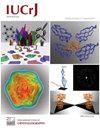Tracking anharmonic oscillations in the structure of β-1,3-diacetylpyrene
IF 3.6
2区 材料科学
Q2 CHEMISTRY, MULTIDISCIPLINARY
引用次数: 0
Abstract
A recently discovered β polymorph of 1,3-diacetylpyrene has turned out to be a prominent negative thermal expansion material. Its unique properties can be linked to anharmonic oscillations in the crystal structure. The onset and development of anharmonic behavior have been successfully tracked over a wide temperature range by single-crystal X-ray diffraction experiments. Sufficient diffraction data quality combined with modern quantum crystallography tools allowed a thorough analysis of the elusive anharmonic effects for a moderate-scattering purely organic compound.
A recently discovered β polymorph of 1,3-diacetylpyrene has turned out to be a prominent negative thermal expansion material, with a linear thermal expansion coefficient of −199 (6) MK−1 at room temperature. Its unique properties can be linked to anharmonic oscillations in the crystal structure that can be attributed to several weak C—H⋯O interactions. The onset and development of anharmonic effects have been successfully tracked over a wide (90–390 K) temperature range using single-crystal X-ray diffraction. Experimental data of sufficient quality combined with Hirshfeld atom refinement of the crystal structures enabled a quantitative analysis of elusive anharmonic effects within the Gram–Charlier formalism. This example highlights that quantum crystallography tools can and should be applied in structural analysis even for data collected at high temperatures as well as of standard (∼0.8 Å) resolution.
追踪 β-1,3-二乙酰基苯乙烯结构中的非谐波振荡。
最近发现的 1,3-二乙酰基苯乙烯的一种 β 多晶体是一种突出的负热膨胀材料,室温下的线性热膨胀系数为 -199 (6) MK-1。这种材料的独特性质与晶体结构中的非谐波振荡有关,而非谐波振荡可归因于几种微弱的 C-H...O 相互作用。利用单晶 X 射线衍射技术,我们成功地跟踪了非谐波效应在 90-390 K 宽温度范围内的发生和发展。质量足够高的实验数据与晶体结构的 Hirshfeld 原子细化相结合,在 Gram-Charlier 形式主义中对难以捉摸的非谐波效应进行了定量分析。这个例子突出表明,量子晶体学工具可以而且应该应用于结构分析,即使是在高温和标准(∼0.8 Å)分辨率下收集的数据也是如此。
本文章由计算机程序翻译,如有差异,请以英文原文为准。
求助全文
约1分钟内获得全文
求助全文
来源期刊

IUCrJ
CHEMISTRY, MULTIDISCIPLINARYCRYSTALLOGRAPH-CRYSTALLOGRAPHY
CiteScore
7.50
自引率
5.10%
发文量
95
审稿时长
10 weeks
期刊介绍:
IUCrJ is a new fully open-access peer-reviewed journal from the International Union of Crystallography (IUCr).
The journal will publish high-profile articles on all aspects of the sciences and technologies supported by the IUCr via its commissions, including emerging fields where structural results underpin the science reported in the article. Our aim is to make IUCrJ the natural home for high-quality structural science results. Chemists, biologists, physicists and material scientists will be actively encouraged to report their structural studies in IUCrJ.
 求助内容:
求助内容: 应助结果提醒方式:
应助结果提醒方式:


